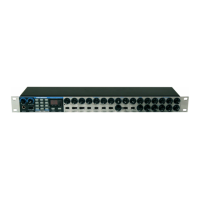21
Filter
many of the classic Filters such as the Moog type, Oberheim
type and Roland TB303* type.
If the A-Station produces a high pitched whistling sound, it is
probably due to this knob is being adjusted too far clockwise. If
this self-oscillating effect is not desired, keep the Resonance
control away from the extreme clockwise setting. Increasing the
Resonance is very good for bringing out modulation (movement
or change) in the filter Cut off frequency, such as in Acid bass
lines and other very edgy sounds.
K’YBD Track Knob
Controls the amount of change to the filter Cut off (set by the
Frequency knob) by the pitch of the note played. Set fully anti-
clockwise and there is no change to the filter Cut off frequency.
With clockwise movement there will be an increasing amount of
modulation. The filter will be opened more as higher notes are
played on the keyboard. This control is used to define how the
timbre of a sound changes over the keyboard. At the 10 posi-
tion the filter tracks the pitch changes in a 1 to 1 ratio.
Mod Env Knob
Controls the amount of change to the filter Cut off (set by the
Frequency knob) by the Modulation Envelope. In its central
position there is no change to the filter Cut off frequency.
Adjusting the knob anticlockwise from centre will introduce an
increasing amount of negative modulation. The filter will close
as the MOD ENV runs through its cycle. Adjusting the knob
clockwise from centre will introduce an increasing amount of
positive modulaton. The filter will be opened by the MOD ENV.
LFO 2 Depth Knob
Controls the amount of change to the filter Cut off (set by the
Frequency knob) by LFO 2. In its central position there is no
change to the filter Cut off frequency. Adjusting the knob anti-
clockwise from centre will introduce an increasing amount of
negative modulation. The filter will close and open in time with
LFO2 (this creates the popular wow wow effect).
Adjusting the knob clockwise from centre will introduce an
increasing amount of positive modulaton. The filter will open
and close in time with LFO 2.
NOTE : An external audio signal such as a microphone, guitar
or CD player may be processed by the filter and effects. Refer
to pages 50, 54 and 55 in the Advanced Features Chapter for
more details on setting up this feature.
*TB303 is a trademark of the Roland corporation of Japan
Main features and operation

